……and a Red-tail in an Oak Tree 
Merry Christmas to All!
My alarm went off promptly at 5:00 am. I tried to hit the snooze, but then realized my watch did not have a snooze, and I knocked it off the night stand. It landed somewhere in the darkness of the bedroom, still sounding the steady, soft beeping. I opened my door, stumbled toward my sister Cathy’s room to gently yell to her to get up, but she was already headed toward the coffee pot in the kitchen. It was time to get up. It was owling time!
Believe it or not, we were probably part of thousands of volunteers that were getting ready to head outdoors well before sunrise in search of a few nocturnal birds. We were participating in National Audubon’s Annual Christmas Bird Count-the longest running citizen science project in the world. The 2014 count marks the 115th year of collecting bird data that tracks long term population changes. Cathy and I volunteered to help in our home area, as part of the Bloomsburg Christmas Count.
What is a Christmas Bird Count? It’s just as its name implies-a bird count that occurs during the Christmas season (not actually on Christmas Day). Small groups of volunteers travel in assigned areas within a pre-determined, 15-mile diameter circle and record every bird they see or hear. The one day count happens between December 14, 2014 and Monday, January 5, 2015. Why do we do this? It’s fun, it gets us outdoors, we see lots of birds (and other critters), we meet new people and we’re contributing to a very worthy project!

If you decide to participate in a Christmas Bird Count there’s a few items you should have in your “toolkit.” First, a bird book and a decent pair of binoculars to see the birds. They shouldn’t have double vision or you’ll be counting every bird twice! Also, if they come with caps to cover the eye pieces, it usually helps if you remove them first, or everything you try to view will look like an extreme close-up of a blackbird! Next, is coffee and snacks. Coffee keeps you warm and keeps you going! When it comes to snacks, don’t be too picky. Apples, granola bars, peanuts, cookies, banana muffins, chips, pretzels, beef jerky and anything else you can pick-up at the local convenience store or get a sister to bake! For some unknown reason, counting birds makes you hungry, and you find yourself nibbling just as often after seeing a Red-tailed hawk for the first time that day, or seeing your 850th European Starling. Next, you should bring lots of water to drink. You get very thirsty eating all those snacks. Also, if you’re covering an area that’s fairly rural and with no public restrooms nearby, I would recommend a roll of toilet paper. Why? Coffee, granola bars, peanuts, cookies, banana muffins, Doritos and beef jerky! Need I say more?

We only managed to see 29 species of birds, but counted almost 1000 (many Starlings and Pigeons)! We were fortunate to find a small flock of Horned Larks after much looking, had good looks at Bluebirds, Mockingbirds, American Kestrels and lots of juncos and sparrows. Sister Cathy spotted a Northern Harrier taking off just in front of us. A good find in any count! It really didn’t matter how many birds we observed, we had a great time, saw lots of critters, traveled through some beautiful areas and had the opportunity to spend some time with some old friends, and many dedicated volunteers. It was a great, early Christmas present, and I can’t wait until the 2015 “count season!”


If you’re one of the millions who choose to put up a live Christmas tree each year, what are your reasons for selecting the perfect tree? Is it purely the species, like a Fir or Pine? Is it based on the size, shape and fullness? Does the scent (smell) of the tree have anything to do with it? Or, is it merely a matter of economics-who is it selling them for the cheapest price? Whatever your criteria, picking out that flawless tree can become quite a quest! Even more so, if you prefer to cut your own.
In the days immediately following Thanksgiving, it seems like small herds of fresh cut Christmas trees begin migrating to every corner, vacant lot or large parking area. Signs of all sizes appear at intersections directing you to drive 10 miles out of your way for the “best selection.” Christmas tree farms are a huge agricultural industry, with much of the business conducted in about 6-week season.

Cutting your own tree has become quite a trend in recent years. In our area, there is at least a half dozen Christmas tree farms that go all out for your visit. When you arrive, you’re greeted with a cup of hot chocolate and then guided to a tractor-driven (or horse-drawn) hay wagon that will carry you to a field full of natural, emerald-colored evergreens waiting to be cut. To top it off, you can finish your outing with a quick stop in their Christmas shop to purchase an ornament or wreath to compliment your new tree. It’s truly an all-day experience! However, the “experience” of cutting your own tree certainly has changed over the years.
In 1975, my oldest brother, Jimmy, pioneered a legendary approach for obtaining your own live Christmas tree. It was short-lived, but extremely resourceful and quite entertaining! He recruited (bribed?) my sister Cathy and somehow convinced Pa they could handle the task of acquiring a live tree for the Wood Family Christmas. After trekking through our back woods, my brother declared he had found the perfect tree-it didn’t really matter that it was 40 feet above their heads! You see, his plan was to climb a large Hemlock and cut off the top 8 feet, since the top seemed to be just what we needed in our living room! So, with the skills of Paul Bunyan and handsaw slung over his back, he ascended, branch after branch, until he reached his goal. After a few quick strokes of the saw blade, our new tree came crashing down to the ground, scattering birds and squirrels in every direction and sending my sister diving for cover! Not until they dragged it back to the house and squeezed it through the door, did Jimmy discover it was about 5 feet taller than our living room ceiling. Nothing that a few strokes of the hand saw couldn’t fix! We’ll always remember that Christmas as the year Jimmy re-defined “trimming the tree!”

Today, many large U.S. cities also put up live trees to celebrate the holiday season, including New York City’s famous Rockefeller Center. As a matter of fact, this year’s Big Apple tree came from right here in Pennsylvania, a towering 85-foot Norway spruce from Danville. The White House, too, looked to PA for its honorary tree in 2014. An 18’ Douglas fir, grown at Crystal Springs Farm in Lehighton, has been named the Grand Champion tree and will be displayed in the Blue Room. In the Keystone State, Christmas trees are grown in every County except Philadelphia, and Pennsylvania ranks in the top five states in the U.S. for number of trees grown.
An added benefit of real Christmas trees is the habitat they provide for wildlife. While growing in the fields, many species of birds may use them for nesting sites. After the holidays, they can be recycled by putting them back outside to act as cover for wintering wildlife, or having them chipped into mulch. Of course, all those growing evergreens also help in providing oxygen for people to breathe. Whatever your vision of the perfect tree might be, don’t wait too long, before you know it, all those “premium cut trees” will be gone! Good Luck with your search!
